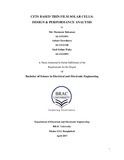CZTS based solar cells: design & performance analysis
Abstract
In recent year’s climate change and renewable energy resources were put into the limelight to a
greater extend. The main limitations of fossil fuels are that they are a finite resource and release
CO2, a greenhouse gas implicated in an-made climate change. Thus renewable energy sources
have gained greater importance and of those, solar energy is one of the more encouraging areas
for development. However, electricity from solar cells is more expensive than energy from
conventional sources like coal, gas. One approach to solve this problem is the thin film solar cell.
Thin film solar cells have a thickness of only few micrometers which means less material is used
which saves energy and money.
Copper zinc tin sulphide or CZTS is a compound semiconductor made of copper, zinc, tin and
sulphur which are sufficiently abundant elements and none of them are harmful to the
environment. CZTS is a material with promising electrical and optical characteristics with the
advantage that it is made of nontoxic and less expensive materials compared to many other thin
film materials, making it a compound of interest in the search for suitable materials for thin film
solar cells.
The goal of this work is to select a CZTS-based solar cell design and evaluate its performance
under different parameters and conditions, namely doping density, thin film thickness and
temperature to find

